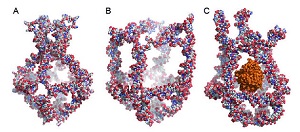 |
| A DNA-based nanorobot is (a) closed and empty, (b) open and (c) closed with enzyme cargo.--Courtesy of Aarhus University |
Tiny, programmed drug-delivery vehicles called nanorobots have the potential to bring about more targeted treatments with fewer side effects. And a research team from Denmark has built the beginnings of a DNA-based cage capable of holding and releasing drugs in such a programmed way.
Along with scientists from the U.S. and Italy, the team from the Danish Aarhus University has created intricate DNA nanocages that can open and close like a drawstring bag depending on the temperature of their surroundings. In the very early stages, they demonstrated the cage's ability to encapsulate the enzyme horseradish peroxidase and then release it again on demand, as published in the journal ACS Nano.
The cage itself is intricately designed with double-stranded DNA helices that make up the holding part of the structure, as well as four small stretches of DNA that act as the drawstrings. When exposed to higher temperatures, the four sequences contract and enclose or release the cage's cargo. By design, the cage opens at 37 degrees Celsius and stays closed at 4 degrees Celsius.
The entire vehicle has also shown the ability to penetrate cells in culture, according to an Aarhus University report.
The enzyme used for the study in animals is different from the drugs the cages could soon carry, but the programmed opening and closing of the cage, as well as the continued activity of the enzyme, show that these nanorobots could someday be an important tool for drug delivery, offering more targeted, efficient treatments.
- here's the Aarhus University report
- and here's the ACS Nano study